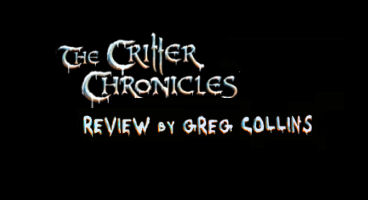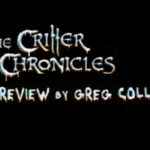
The Critter Chronicles – Prequel to The Book of Unwritten Tales
This stand-alone add-on tells the story of how Nathaniel Nate Bonnet and his strange companion Critter first met
 





Genre: Fantasy Adventure
Release Date: 2012
Platform: PC, Mac
Version played: Steam (on PC)
Was it really only fifteen months ago that I reviewed The Book of Unwritten Tales, that polished homage to the classic third-person LucasArts point-and-click adventure? Now, we have a prequel to TBoUT called The Critter Chronicles, in which we learn how that curious duo of derring-do, Nate and Critter, first met up. (Actually, somewhere in between I played the German demo of CC, which includes the game’s full first chapter. Had no clue what anyone was sprechen, but enjoyed it anyway.)
So, what’s changed? Not much; a good idea as the first game got pretty much everything right. One not-so-obvious difference is that the minimum requirements have been jacked up. The first game ran beautifully on my 2.2 ghz laptop, but CC requires 2.4 ghz. Luckily, the game’s options let me knock down the graphics and all went swimmingly. In fact, I didn’t notice much difference.
Another curious thing that’s happened since last we visited the mystical and frequently wacky land of Aventasia is the arrival of a hard mode! Will wonders never cease? Since I spent a good chunk of my TBoUT review whining about how the whole darn adventure gaming world was obediently plodding along in Telltale Game’s easy-peasy footsteps, I admit I was gratified. Not, I know, that I had anything to do with it. Like most graphic adventures of recent years, CC came out over a year ago in Germany. Still, I welcome the change, whoever prompted it.
In the new, improved hard mode, players get a few more puzzles and a few fewer blatant clues, and the now near-universal “space bar illuminates hotspots” feature is automatically disabled. Did it make a big difference? Well, yes, sort of. I didn’t go back and replay the game’s five chapters in normal mode to compare, but judging by my experience playing the first game I’d say the new hard mode is a far happier choice for veteran adventure gamers. Just the absence of the infuriating Tutorial Mode is a blessed relief. The characters still throw you a line when they see you spending too much time having fun doing something other than advancing the game, but at least not as frequently.
Those who haven’t played the first game are no doubt wondering “Should I play the first game first — that is, the second game, in terms of story, but the first game in terms of release?” No, I don’t think so. You’ll miss a few jokes and a few references if you start with Critter, but not much else.
To refresh: In TBoUT, Nate and Critter showed up as a team to help the elf princess Ivo and the gnome Wilbur defeat Munkus and his evil anemone mother (anemom?). Nate is one of the few humans in Aventasia and Critter is a sort of Errol Flynn-like Cookie Monster. The prequel begins with Nate on his stolen pirate airship trying to flee Ma’zaz, the orc bounty huntress, when he runs, literally, into a flying iceberg. Said iceberg happens to serve as the temporary home of a curious explorer named Cornelius and a spaceship full of marooned Critters. In the game’s subsequent four chapters we learn of Critter’s undying love for Layla, the boss’s daughter, then how Critter and Nate meet, and finally watch them defeat once again (well, chronologically, for the first time) our old fiend Munkus.
Critter Chronicles doesn’t have as many characters or as much plot as the first game. In fact most of the action takes place on that relatively cramped iceberg. For the final three chapters you do get to switch between Nate and Critter, which helps expand the gameplay. Also, our two heroes manage to get away for one chapter to Seastone. As you may or may not recall, Seastone is the location of the Arch-Mage’s magical tower. This is easily the best chapter in the game. While it borrows its gravitational tomfoolery from such earlier games as Obsidian and Ankh 3, it does so with cleverness. This is also the most challenging section, including a couple of actual standalone puzzles.
Hard mode is certainly a welcome addition but CC does still suffer a bit from Telltale-itis. The folks at King Art clearly took a lot of trouble building outrageous conundrums in CC. Unfortunately, the sheer limited number of “possibilities” often tempts the player to use brute force over exploration and cogitation. One example: In that Seastone chapter the whole objective is to open the combination lock to the Arch-Mage’s office door. But the lock is so simple it takes only a few minutes to open it once you get part of the solution. I had to compel myself, after I’d popped the door, to go back and play the level the “correct” way.
A good puzzle should only seem difficult if you, the player, haven’t yet put together, or discovered, all the clues. This is what makes adventure games fun and what gives a player that delicious “ah-ha” moment. Tutorial modes and hotspot highlighters and all the rest of the panoply of modern “help” aren’t really helping anybody except the production company’s puzzle constructors. Modern game designers have got down the cartoon graphics and the screwball plots of those old LucasArts classics, but they have yet to consistently duplicate the brilliant clockwork puzzle design.
There’s nothing new to mention about Critter Chronicle‘s graphics, music, sounds, production, and voice acting. Just like the first game all are top-notch. One welcome change is the dialing-down of the pop culture references that threatened to capsize the first game. There are a bunch here too, but better spaced. Or maybe I simply didn’t catch them. Either way, a blessing. There’s one hilarious cameo appearance by a famous LucasArts villain that I won’t spoil for you.
Critter Chronicles thus improves on some things over TBoUT, but is somewhat shorter and less of a grand, globe-trotting adventure. It took me 20 hours to complete the first game and about 15 to finish Chronicles. But if you enjoyed the first entry you will enjoy this one. Though I did experience some frustration at never being allowed to yank that pull-tab on the back of the tin-canned Black Guards. Maybe next time.
I should mention that I played Critter on Steam. The game downloaded and ran smoothly, though I’m still not enticed by all those gaming community perks and extras. There is, on Steam’s CC game panel, a listing of unlocked achievements. Most of these are of the goofy variety, but fun. My sole Steam complaint was having to hunt for the manual in the game folder.
Like the first tale in the Book of Unwritten Tales, this second one deserves kudos for just about everything. Only its shortish length and mildly schizophrenic puzzle design dilute its well-produced rollicking good fun. I give Critter Chronicles a well-earned A minus.
PC – Minimum System Requirements
- OS: Windows XP/Vista/7
- Processor: Intel Pentium 4 @ 2.4 GHz / AMD Athlon XP 2500+
- Memory: 2 Gb
- Hard Drive: 6 Gb free
- Video Memory: 128 Mb
- Video Card: nVidia GeForce 6600 / ATI Radeon X800
- Sound Card: DirectX Compatible
- DirectX: 9.0c
- Keyboard
- Mouse
- DVD Rom Drive
Recommended System Requirements
- OS: Windows XP/Vista/7
- Processor: Intel Pentium 4 @ 3.2 GHz / AMD Athlon 64 3500+
- Memory: 4 Gb
- Hard Drive: 6 Gb free
- Video Memory: 256 Mb
- Video Card: nVidia GeForce 7800 / ATI Radeon x1800
- Sound Card: DirectX Compatible
- DirectX: 9.0c
- Keyboard
- Mouse
- DVD Rom Drive
Mac – Minimum System Requirements
- Mac OS X 10.6/Mac OS X 10.7
- 1.5 GHz Intel Mac Core Duo
- 1.5 GB RAM
- 6 GB free hard disc space
- Intel GMA-950-grapgic card with 256MB VRAM or better

Leave a Reply